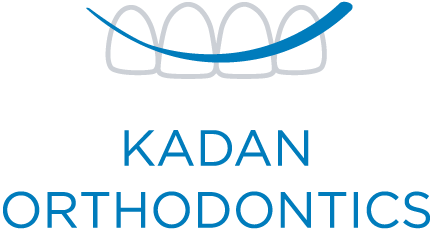What Is Two-Phase Treatment?
As the name indicates, two-phase orthodontics involves two distinct phases of treatment for children. The problems are usually identified during the child’s first orthodontic evaluation, which should occur around seven years old. Estimates indicate that one in 10 children require two-stage orthodontics. In Phase I, Dr. Kadan and the team at Kadan Orthodontics focus treatment on correcting any abnormalities in jaw development that affect the bite pattern. Having treatment early ensures that the adult teeth grow in properly thus reducing the likelihood of future extractions or at least minimizing the number of extractions. Phase I is designed to treat common problems in the early stages, such as:
- Severe crowding
- Problems related to tooth eruption
- Large overbites
- Deep bites
- Open bites
- Crossbites
- Front teeth that are severely protruding
- Narrow jaws
- Habits that may be harmful to oral health and tooth development
Phase II of treatment involves standard orthodontic treatments to align the adult teeth.
Two Phase Braces
The phrase “two-phase braces” describes the use of orthodontic appliances at two points in tooth and bone development. Dr. Kadan may recommend braces early in your child’s life to promote healthy alignment of the teeth and jaw. The second set of braces is used during the adolescent years once the adult teeth have fully emerged.
What are the Advantages of Two Phase Orthodontic Treatment?
Two-phase orthodontics combines modifications to the facial structure and alignment of the teeth. The overall goal of this approach is to give your child the greatest potential for developing and maintaining a healthy smile, as well as optimum tooth and jaw function.
What If Treatment is Delayed?
Unfortunately if treatment is delayed, your child may face more extensive and invasive procedures in the future. Once the adult teeth develop and the jaw bone stabilizes naturally, the options for correcting any abnormalities may be much more limited.
What is Phase I Orthodontic Treatment?
As a board-certified orthodontist, Dr. Kadan recommends Phase I orthodontics when your child is seven to 10 years old and still has the baby teeth. The primary goal of Phase I orthodontics is proper jaw development to allow the adult teeth to properly erupt.
Benefits of Phase I Treatment
You may have noticed signs of a jaw problem in your child or observed baby teeth that are not properly positioned or overcrowded. Early treatment with Phase I orthodontics gives your child the best chances of avoiding future problems. Phase I orthodontics:
- Improves the width of the dental arches
- Reduces and possibly eliminates the need for jaw surgery
- Influences jaw development in a positive way
- Supports efforts to correct adverse oral habits
- Enhances the aesthetics of the teeth and smile while boosting self-confidence
- Minimizes and possibly eliminates the need for extractions in the teenage years (Phase II orthodontics)
- Improves speech development
- Simplifies and shortens Phase II orthodontic treatment
- Improves the alignment of the permanent teeth as they erupt
Do All Children Need Phase I Orthodontic Treatment?
Dr. Kadan recommends Phase I orthodontic treatment for children with moderate to severe problems with their bites, such as open bites, underbites, and crossbites, a condition involving teeth being nested inside the lower set of teeth. Having severely misaligned and overcrowded teeth in a young child is another indication that Phase I treatment is needed. Phase I treatment is intended to create a proper bed for the eruption and alignment of the permanent teeth. Doing this type of treatment in the early stages of tooth development alleviates the need for more complex treatments in the future.
The primary cause of advanced orthodontic issues in children is improper jaw development. The jaw bones may develop at different rates. Early treatment involves the use of orthodontic appliances that are similar to braces or retainers to guide the teeth and jaw to develop properly. Dr. Kadan may also use orthodontic expanders to address overcrowding and a crossbite. The details of your child’s treatment are determined during the consultation.
Resting Period
Any untreated teeth are left to develop naturally, and in most cases retainers are not necessary. Allowing a degree of natural development is beneficial. A successful Phase I orthodontic treatment will leave adequate space for these teeth to develop. In rare cases, permanent teeth do not develop properly due to being severely displaced or impacted.
Dr. Kadan integrates a resting period into his two-phase orthodontic plans to allow the teeth to shift naturally. Your child will still need Phase II orthodontics to shift the teeth into the final position. He may opt to remove some baby teeth as part of the resting period. You should anticipate follow-up appointments every six months so that Dr. Kadan can monitor your child’s progress.
What is Phase II Orthodontic Treatment?
After the resting period, your child may require Phase II orthodontic treatment to finalize the corrective process. The phase is more straightforward than Phase I and typically requires less time for full treatment. Phase I treatments can take six to 18 months followed by a resting period of 12 to 24 months. Phase II typically takes another 12 to 24 months which is a much shorter time period than what would be needed without the early treatment of Phase I orthodontics.
What is Comprehensive Treatment?
Comprehensive treatment usually begins around 12 years of age and involves the use of braces and other orthodontic treatments. Children and teenagers who undergo comprehensive treatment require only one phase of treatment that takes 12 to 30 months.
Your child may be a candidate for comprehensive treatment if the teeth are not overcrowded, and there are no problems with the bite that necessitates early (Phase I) treatment. Other problems that can be resolved with comprehensive treatment are:
- Severe bite problems that are treatable when the child is experiencing a growth spurt
- Severe bite problems requiring earlier intervention
Why Does the American Association of Orthodontists Recommend that All Children Be Examined By an Orthodontist at Age 7?
The American Association of Orthodontists recommends an orthodontic evaluation when your child is seven years old, an age that coincides with the initial eruption of the permanent teeth. This phase of development is the opportune time to evaluate jaw development for any abnormalities and to define an intervention that will alleviate future complications and more complex treatments.








